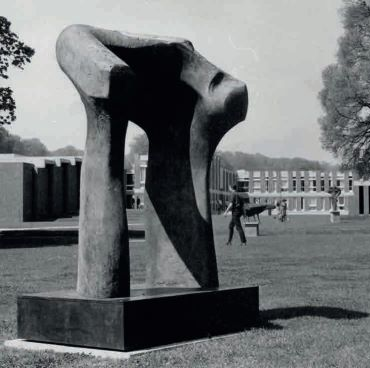
Students sat on it, danced around it, draped themselves across it, loved it, loathed it, ignored it… and then it was gone.
Henry Moore’s two-metre-high bronze cast, LH503 Large Torso: Arch, was a distinctive feature of the University of Sussex campus in the late 1960s and early 1970s, its bold, bone-like contours complimenting Sir Basil Spence’s ‘brutalist’ architecture.
However, the sculpture’s sojourn at Sussex was not without controversy, and its departure is tinged with ignominy.
Moore was one of the most important and influential British artists of the twentieth century, producing more than 10,000 artworks. But he is best-known for his semi-abstract, monumental bronzes that are now found on public display all over the world.
The piece at Sussex – one of a series of seven cast between 1962 and 1963 – first arrived in 1965 as part of a touring exhibition of contemporary British sculpture organised by the Arts Council. It featured among works by Brian Wall and Austin Wright that were temporarily installed in outdoor locations across campus during May of that year.
The following month, Moore attended the university’s summer graduation ceremony to receive an honorary doctorate. In making the presentation, Patrick Corbett, professor of philosophy, paid tribute to Moore’s “bronze immensities” and “…his refusal to be confined within the established formalities…”
He said of Torso: “All the ages of human strength are alive within that massive arch, and unfold themselves before the speculative eye; what, to the ignorant, is incompleteness and distortion, represents to the judicious the primal force of life.”
Six months later, it was back on campus between Falmer House and the Library, for what was initially intended to be a two-year loan.
Photographs from the university’s archives reveal how it became a convenient perch for student bottoms, a handy frame for sports team photographs, and it even served as prop for a student film, Fire Over Falmer, which featured Russian-style revolutionaries dancing around it and setting off flares. A miniature version was also made (although not by the artist) for a scaled-down model of campus.
But it didn’t impress everyone. Emeritus Professor of Art History David Mellor, who was also a student at the university in the late Sixties, remembers that he and his fellow students already regarded Moore as ‘ancient history’.
He says: “The rumour about its disappearance – a little while later – was that Henry Moore was distressed that it had been treated in some disparaging way, or just ‘disrespected’, and he had withdrawn his loan/gift.”
Indeed, this seems to be the case. According to the archives of the Henry Moore Foundation, this particular cast was recalled in 1973 for an exhibition in Tokyo following the revelation that the sculpture had been tipped over and damaged by students – and the university offered to foot the bill.
As to its current whereabouts, the foundation has not been able to identify which of the casts was at Sussex (it was possibly 0 or 4). Rumours that it was seen shortly after at Glyndebourne have also not been verified.
So Torso is long gone from Sussex. But the memory, some photographs, and a tiny version still remain.
Words by Jacqui Bealing

